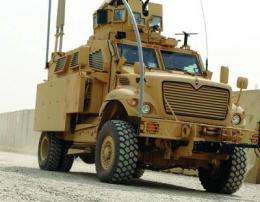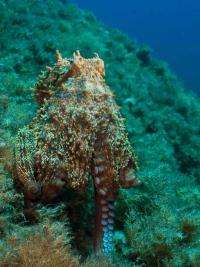When it comes to security, think 'natural'

Security systems could be more effective if officials looked at how organisms deal with threats in the natural world, University of Arizona researchers suggest in the May 20 edition of the journal Nature.
The authors are working with security and disaster management officials to help put some of their recommendations - such as decentralizing forces and forming alliances - into practice.
"Anytime you have the illusion of full security, you get adaptation," said Rafe Sagarin, an assistant research scientist in the UA's Institute of the Environment who is the lead author of the opinion piece. "Terrorists figure out unexpected means of attack, hackers come up with new software to break through firewalls, and pathogens develop resistance to antibiotics."
Instead of relying on large, centralized bureaucracies that move slowly and often lag behind in addressing threats, the authors encourage officials to look to the natural world for principles that could prove less costly, more flexible and more effective at countering threats.
The security issues of modern human societies are analogous to those of many organisms, according to Sagarin and his co-authors. In nature, risks are frequent, variable and uncertain. Over billions of years, organisms have evolved an enormous variety of methods to survive, grow and proliferate on a continually changing planet. The key to their success is their ability to quickly adapt to rapidly changing threats, and change their structures, behaviors and interactions accordingly.
Avoid centralization
Unlike many security agencies or entities in the human world, the most adaptable and successful organisms avoid centralization. Instead, they distribute tasks among decentralized, specialized groups of cells or individuals.
Sagarin points to the octopus' camouflaging strategy to illustrate this principle: Its networks of pigment cells, distributed all over its body, react to and match the colors of the surroundings, blending the animal into the background.
"We can learn something from the octopus about the war in Iraq and Afghanistan," Sagarin said, specifically with regard to the threat from improvised explosive devices, or IEDs.
Just like the octopus' decentralized network of pigment cells, he pointed out, troops on the ground function like independent sensors that can assess a threat more accurately, more timely and more realistically than a large, centralized organization that is geographically removed from the action and largely follows a top-down approach of command.
"The individual soldiers in the war zone are the most adaptable unit out there," he said. "They are in a better position to recognize and address an emerging threat in time than a centralized bureaucracy."
Sagarin and co-authors point out that terrorist networks such as Al Qaida have recognized the advantages of this approach and operate a loose network of largely independent subgroups.
"About 1,500 soldiers had died from roadside bomb blasts between the time troops identified the threat and the time MRAPs (mine-resistant, ambush-protected vehicles) were deployed to deal with the situation."
Even after the blast-resistant vehicles arrived, they proved only moderately effective against a quickly moving threat that is constantly changing and rapidly adapting to new challenges.
"These MRAPs are huge, lumbering things that weigh 16 tons," Sagarin said, "The insurgents, on the other hand, drive around in small pickup trucks. They quickly figured out the MRAPs were limited to certain roads and started placing roadside bombs specifically along those routes."

Let the attacker know you're ready
Another lesson could be learned by looking at how organisms deal with the constant threat from predators, according to the authors. A key feature is the capacity to reduce uncertainty and turn it into an advantage.
Hunting prey uses a lot of energy, Sagarin explained, which is why predators seek to ambush their prey. As soon as the prey is aware of their presence and ready to engage in defense, a pursuit might no longer be worth it.
Ground squirrels, for example, use alarm signals when a predator is lurking nearby, not only to warn their peers, but also to make it known to the attacker its cover is blown.
"When a prey species makes an alarm call of any kind, the game is up," Sagarin said. Suddenly, things have become a lot harder - if you're a hawk, you want to swoop down on a squirrel and not get scratched in the face."
Remarkably, ground squirrels use alarm signals that are very specific to the threat. If the predator is a mammal (which can hear), they utter alarm calls. If it is a snake (which cannot) they use tail-flagging to signal its presence.
The less specific an alarm call is, the less efficient it is in eliciting an appropriate response, the authors argue and point to the U.S. Homeland Security's threat advisory for national and international flights, which has remained at level orange (high) since August 2006. This static, ambiguous and nonspecific system creates uncertainty or indifference among the population that it is meant to help protect.
Form allies
Another principle often observed in nature is symbiosis, the formation of allies.
"Symbiosis is not always between friends," Sagarin said, pointing to the example of cleaner wrasses, small fish specializing in picking parasites off other marine animals, sometimes entering their mouths. The clients could easily swallow the cleaner wrasse while it is going about its job.
"But they don't," Sagarin said. "It's a mutual beneficial relationship in which the larger fish provides the cleaner fish with a food source and protection, and the cleaner keeps it free from parasites in return."
A lesson of how symbioses can successfully be applied in the human realm was demonstrated in Iraq in 2007, the authors note, when Gen. David Petraeus's strategy to form alliances with local leaders - including those who had been hostile - resulted in more tip-offs about IEDs and fewer American casualties.
Issue challenges
Two years ago, Sagarin and colleagues published a book titled "Natural Security: A Darwinian Approach to a Dangerous World." The research group has since begun to "make its observations more actionable for the people on the ground," as Sagarin put it. Working with emergency management coordinators, cybersecurity experts, soldiers, police chiefs, air marshals, homeland security officials, fire chiefs and public health officials, the group's ideas have generated a lot of interest.
"One of the main lessons we learned is that issuing challenges is more effective than giving orders when there is a need to develop security measures," Sagarin said. He pointed to the DARPA Grand Challenge as an example, in which the Defense Advanced Research Projects Agency of the Department of Defense put on a prize competition for the development of a driver-less vehicle capable of navigating difficult terrain on its own.
"Anytime you pose a challenge, not only do you get a diverse population of problem solvers, but you get them to learn from each another."
However, despite decentralization, it is important to still have an overarching structure to provide guidance and encourage the development of new ideas.
"An octopus is still an octopus," Sagarin said, "not just a random collection of cells."
"The bottom line of all this is, you can't just put up a wall around something and expect it to protect it against every possible threat. Attackers will always figure out a way."
More information:
"Decentralise, adapt and cooperate," Rafe Sagarin et al., Nature, Vol. 465, May 20, 2010.
"Natural Security - A Darwinian Approach to a Dangerous World," Raphael Sagarin and Terence Taylor, University of California Press, 2008.
Provided by University of Arizona
















